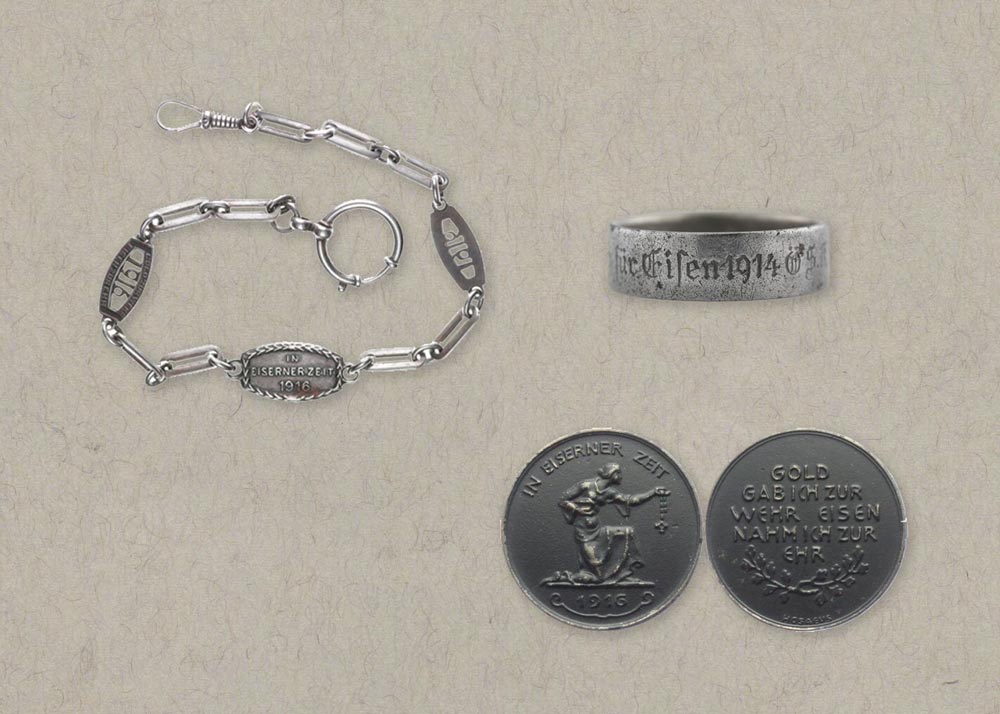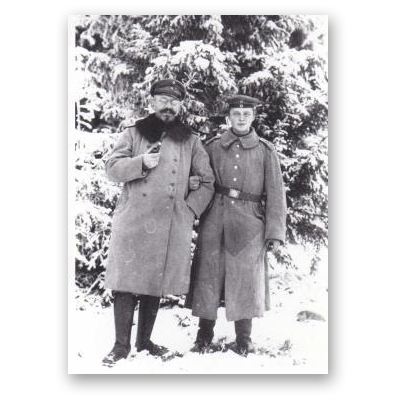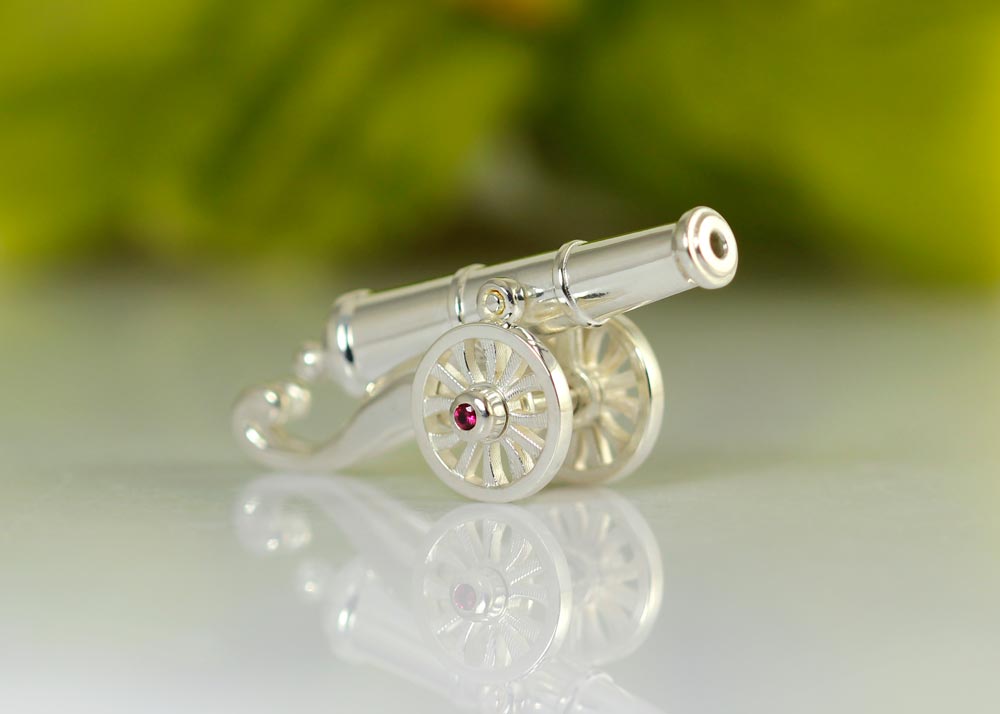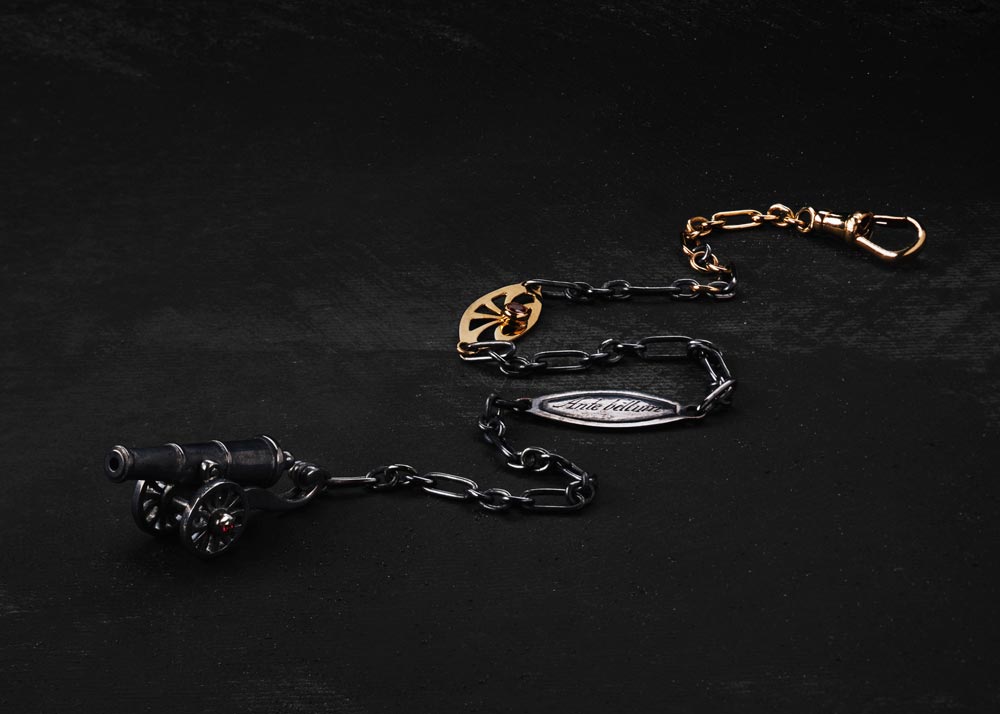Ante Bellum – Gold gab ich für Eisen
If your loved ones must risk their lives and limbs to fight in a war, you sacrifice what you can, in the hope that they will return home unscathed. It is this love that forms the basis of my work for the exhibition "Macabre Masterpieces" at Soderborg Castle.
When I was given the task of creating a piece of jewelry based on the German war concept "Gold gab ich für Eisen", it was obvious to dive into the history of my own family. I grew up as part of the German minority in Southern Jutland, where my father's family has for generations belonged to Haderslev's better bourgeoisie. My assumption that a relative could have donated gold to support the German war effort held true: My father told me that his grandmother (my great-grandmother) Helene Henriette Meyer, born Castens, had once proudly shown him an iron chain, which she had created after donating her own gold watch chain to "Das Vaterland" during World War I.

Helene and Peter Meyer approx. 1893
Usually on that occasion they received a small medallion with the text "”Gold gab ich zur Wehr, Eisen nahm ich zur Ehr“. But if they could afford it, the donor, like Helene, created a copy of the original gold jewelry in iron. In this way, one retained the function of use and at the same time could demonstrate one's patriotism.

Many Germans and German-minded people donated their jewelry to the German defense, both during the First and Second World Wars. Often probably for patriotic reasons, but for many women who stayed at home and had to watch their spouses, fathers, sons and brothers go to war, the primary incentive has probably been another: Maybe the extra weapons, food, or blankets the donated gold could buy, helped ensure that her loved ones came (unscathed) home again?
Helene had good reason to be worried, because both her husband, the doctor Peter Meyer, and their two eldest sons (who were both medical students) participated in the First World War on the German side, although he, no more than the Danish-minded at home in Haderslev, approved of the war. Unfortunately, not everyone survived, and their eldest son Hans Oluf fell in France. So, one could claim that Helene's donated watch chain had at least partially "worked".

Peter and his son Otto Meyer at the Russian Front in 1917
My work
My contribution to the exhibition Macabre Masterpieces is based on a watch chain for women, which is characterized by being a little thinner than the watch chains for men. In return, they were often adorned with small, decorative plaques. To illustrate the transformation from gold to iron, the beginning of the chain - its hooks and the first centimeters, are created from 14k gold and then turn into being created from oxidized silver, which simulates the dark iron.
Two plaques have been inserted along the way. The first is of gold with a ruby, which can be interpreted in two different ways:
1. A sunrise - classic symbol of the donor's hope, by giving his gold to the war effort.
2. An explosion - caused by the weapon located at the end of the chain.
The second plaque is of silver with the engraving "Ante Bellum" - "Before the War" in Latin. The better equipped you are before it starts, the greater the chance of survival.

The chain does not end in a watch, but in a cannon of silver with rubies grasped in the hubs of the wheels. Based on my great-grandmother Helene's donation, the canon was created in what is often referred to as a "Victorian style" or, "Gründerzeit" as the style was called in Germany in the late 1800s.

The cannon is kinetic, as the wheels and the cannon barrel itself are all movable, like a nod to some of the eggs that Fabergé created at about the same time for the Russian tsarist family and which at times contained surprises in the form of miniature means of transport, e.g., a coach with movable wheels.

Photo: Miklos Szabo & Ida Buss
In hoc bello (during this war)
At the moment, war is differently present. War is something that me and my daughter's generation have simply not been used to other than as “entertainment” in books and movies or as something that takes place very, very far away. Considering Russia's attack on Ukraine, I also note that I have gained a more nuanced perspective on my work since I created it in the spring of 2021.
Since World War II, the Germans have been good and peaceful neighbours with whom we would like to trade, visit and are not ashamed to be related to. The last ones who themselves experienced and remember the war are gradually leaving this world. In our day, on the other hand, we live together quite undramatically, not least because the German side has made an active decision to put the imperialist tendencies on the shelf once and for all (Putin could learn something here). The harmonious coexistence is certainly also since the border between our countries has been drawn as a result of a referendum after the First World War. Schleswig was divided into North and South Schleswig respectively and this border demarcation, with subsequent peaceful coexistence, is relatively unique in the world, which is why committees and government representatives from many countries with border challenges have been on a study trip with us.

Unfortunately, this is not the case in Ukraine. When you are at war, whether it is your own or another country's government that has taken the initiative, I imagine that most people will be against - war in general - for so many obvious reasons, that it does not make sense to list them at all. But as war is now a fact, it makes however sense that you as a population try to support "your boys" and then otherwise survive the crisis as best as possible, even if it means fleeing your country. For the vast majority, like my family, it has been about one's own, beloved family members and the fear for their returning from the battlefield at all. This reaction, I believe, both the Ukrainian wives who make Molotov cocktails and the Russian mothers of recruits sent on "exercise" at the Ukrainian border can both relate to. They just want it to stop and see that their loved ones return home again.
In that light, I understand exceptionally well my great-grandmother's donation and I could imagine that I would probably have acted similarly. My thoughts these days go to the Ukrainian people as well as to the millions of Russians who in no way approve of the war that their government has so unprovokedly launched against their "brother people".

Materials used
5g 14k gold
20g 925 sterling silver - oxidized
A total of 0.2ct rubies
(3D work done / sponsored by my little brother, Poul Meyer)
See my war-piece as well as many other beautifull and thought provoking death-inspired jewellery at Sonderborg Castle in Southern Jutland.
Macabre Masterpieces is curated by Nina Hald and will for sure be an exhibition like nothing you have seen before!
8/4 to 23/10 2022.

 RSS Feed
RSS Feed

